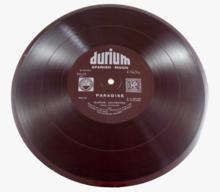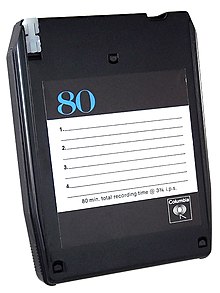An audio format is a medium for sound recording and reproduction. The term is applied to both the physical recording media and the recording formats of the audio content—in computer science it is often limited to the audio file format, but its wider use usually refers to the physical method used to store the data. Note on the use of analog compared to digital in this list; the definition of digital used here for early formats is that which is represented using discrete values rather than fluctuating variables. A piano roll is digital as it has discrete values, that being a hole for each key, unlike a phonograph record which is analog with a fluctuating groove.
Music is recorded and distributed using a variety of audio formats, some of which store additional information.
Timeline of audio format developments
| Year | Physical media formats | Recording formats |
|---|---|---|
| 1805 | Panharmonicon | Digital, automated sound reproducing machine. |
| 1817 | Apollonicon | Digital, automated sound reproducing machine. |
| 1851 | Piano Cylinder | Digital, automatically played by means of revolving cylinders |
| 1857 | Phonautograph | Earliest device known to record sound, invented by Édouard-Léon Scott de Martinville. While this device was capable of recording sound waves, they couldn't be played back. |
| 1877 | Tinfoil Phonograph |  |
| 1883 | Piano roll |  |
| 1886 | Music Box disc |  |
| Late 1880s | Brown Wax cylinder |  |
| Organ Cob | Mechanical digital (vacuum-operated organ) | |
| Ediphone, Dictaphone |  | |
| 1894 | Pathé cylinder |  |
| 1897 | 7'' 78rpm Record (Emile Berliner Patent) | Mechanical analog; lateral groove, horizontal stylus motion - made from hard rubber |
| 1898 | Wire recording |  |
| 1901 | 10'' 78rpm Record |  |
| 1902 | Edison Gold Moulded Record |  |
| 1903 | 12'' 78rpm record | Mechanical analog; lateral grooves, horizontal stylus motion |
| Phonograph Postcard |  | |
| 1905 | Centre-start phonograph Record |  |
| Pathé disc |  | |
| 1907 | Indestructible Record |  |
| 1908 | Amberol Cylinder Record |  |
| 1912 | Diamond Disc |  |
| Blue Amberol cylinder record |  | |
| 1924 | Electrical cut record | Mechanical analog; electrically cut from amplified microphone signal, lateral groove, horizontal stylus motion, discs at 7", 10", 12", most at 78 rpm |
| 1930 | Filmophone flexible record |  |
| Durium Record or Hit of the Week Records |  | |
| 1930s | Reel-to-reel, magnetic tape |  |
| Electrical transcriptions | Mechanical analog; electrically cut from amplified microphone signal, high fidelity sound, lateral or vertical groove, horizontal or vertical stylus motion, most discs 16" at 33+1⁄3 rpm | |
| 1942 | SoundScriber |  |
| 1947 | Dictabelt (Memobelt) | Analog, medium consisting of a thin, plastic belt 3.5" wide that was placed on a cylinder and rotated like a tank tread, developed by the Dictaphone company in 1947 |
| 1948 | Vinyl LP record (Columbia) | Analog, with preemphasis and other equalization techniques (LP, RIAA); lateral groove, horizontal stylus motion; discs 7", 10" and 12" at 33+1⁄3 rpm, 1st LP Columbia ML 4001 Milstein, Mendelssohn Violin Concerto |
| 1949 | Vinyl 45 record (RCA) |  |
| 1950 | Tefifon |  |
| 16 2/3rpm vinyl record |  | |
| 1951 | Minifon P55 |  |
| 1957 | Stereophonic vinyl record |  |
| Dictet |  | |
| 1958 | RCA tape cartridge (Sound Tape) (Magazine Loading Cartridge) |  |
| 1959 | NAB Cart Tape (Fidelipac) |  |
| Synchrofax Sound Paper | Magnetic coating on paper. | |
| 1962 | 4-Track (Muntz Stereo-Pak) | Analog, 1⁄4-inch-wide (6.4 mm) tape, 3+3⁄4 in/s, endless-loop cartridge |
| 1962 | Compact cassette |  |
| 1964 | Sanyo Micro Pack 35 Channel Master 6546 Westinghouse H29R1 |
 |
| 1964 | Sabamobil | A cartridge format for embedding and easy handling usual 3-inch-tape-reels with 1⁄4 inch tape, compatible to reel-to-reel audio recording in 3+3⁄4 ips. |
| 1965 | 8-Track (Stereo-8) | |
| DC-International cassette system |  | |
| 1966 | PlayTape |  |
| 1969 | Microcassette |  |
| Minicassette | Analog, 1⁄8 inch wide tape, used generally for note taking, 1.2 /s | |
| 1970 | Quadraphonic 8-Track (Quad-8) (Q8) |  |
| 1971 | Quadraphonic Vinyl Record (CD-4) (SQ Matrix) |  Recorded two tracks on both stereo channels, requiring a decoder to hear all four tracks. Despite this, the format is playable on any LP turntable. |
| 1971 | HiPac | Analog, a successor of the 1966 PlayTape, using tape width of the 1963 Compact Cassette, Japan only |
| 1976 | Dolby Stereo cinema surround sound | Analog |
| Elcaset |  | |
| 1982 | Compact Disc (CD-DA) |  |
| 1986 | High Definition Compatible Digital (HDCD) |  |
| 1987 | Digital Audio Tape (DAT) |  This audio format famously caused controversy among recording companies when released due to the potential of perfect digital copies to increase piracy |
| 1988 | AIFF (file format) | Digital. Audio Interchange File Format (AIFF) |
| 1992 | Digital Compact Cassette (DCC) |  |
| WAV (file format) | Digital. Named after the waveform created by a sound wave. | |
| Dolby Digital Cinema Sound | Digital. Also known as Dolby Stereo Digital until 1994. | |
| MiniDisc (MD) |  | |
| 1993 | DTS, SDDS, MP3 (file formats) |  |
| 1994 | TwinVQ | Digital. |
| 1995 | RealAudio | |
| 1997 | DTS-CD | Digital. DTS audio |
| 1998 | WavPack (file format) | Digital. PCM, lossless compression (2002 hybrid compression) (2016 DSD support) |
| 1999 | DVD-Audio | Digital. Including Meridian Lossless Packing (MLP), Linear PCM (LPCM), Dolby Digital (AC-3) and Digital Theatre System (DTS) |
| Super Audio CD (SACD) | Digital. Direct Stream Digital | |
| WMA (file format) | Digital. Windows Media Audio | |
| TTA (file format) | Digital. The True Audio Lossless Codec. | |
| 2000 | FLAC (file format) | Digital. Free Lossless Audio Codec (open, non-proprietary, patent-and-royalty-free) |
| Ogg Vorbis (file format) | Digital. Vorbis compressed audio format (open, non-proprietary, patent-and-royalty-free) | |
| DSDIFF (file format) | Digital. DSD, optional DST compression | |
| APE (file format) | Digital. Monkey's Audio | |
| 2001 | AAC (file format) | Digital. Advanced audio coding |
| 2002 | WSD (file format) | Digital. DSD |
| 2004 | ALE or ALAC (file formats) | Digital. Apple Lossless |
| 2005 | DSF (file format) | Digital. DSD |
| 2008 | slotMusic |  |
| Blu-spec CD | Digital. PCM | |
| 2012 | Opus | Digital. Opus lossy audio coding format (IETF standard, open, non-proprietary, royalty-free) |
See also
References
- "The Electrical Era". August 2017.
- Demetris, Jordan (1990-01-01). "The challenge of introducing digital audio tape technology into consumer markets". Technology in Society. 12 (1): 91–100. doi:10.1016/0160-791X(90)90031-7. ISSN 0160-791X.
- ^ Cornell University Library (2003). "Digital Preservation and Technology Timeline". Digital Preservation Management. USA. Archived from the original on August 6, 2015. Retrieved February 28, 2017.
External links
| Digital preservation | |
|---|---|
| Concepts | |
| Techniques | |
| By type | |
| Organizations | |
| Lists | |
| Music technology | |
|---|---|
| Music technology | |
| Sound recording | |
| Recording media | |
| Analog recording | |
| Playback transducers | |
| Digital audio | |
| Live music | |
| Electronic music | |
| Software | |
| Professions | |
| People and organizations | |
| Related topics | |